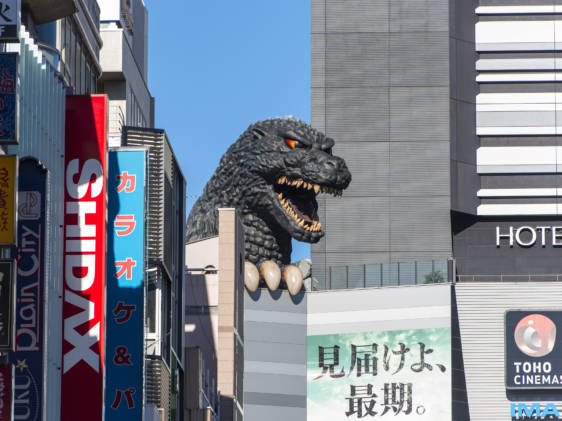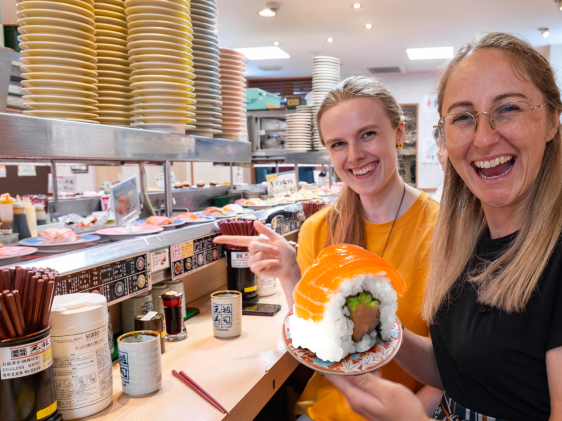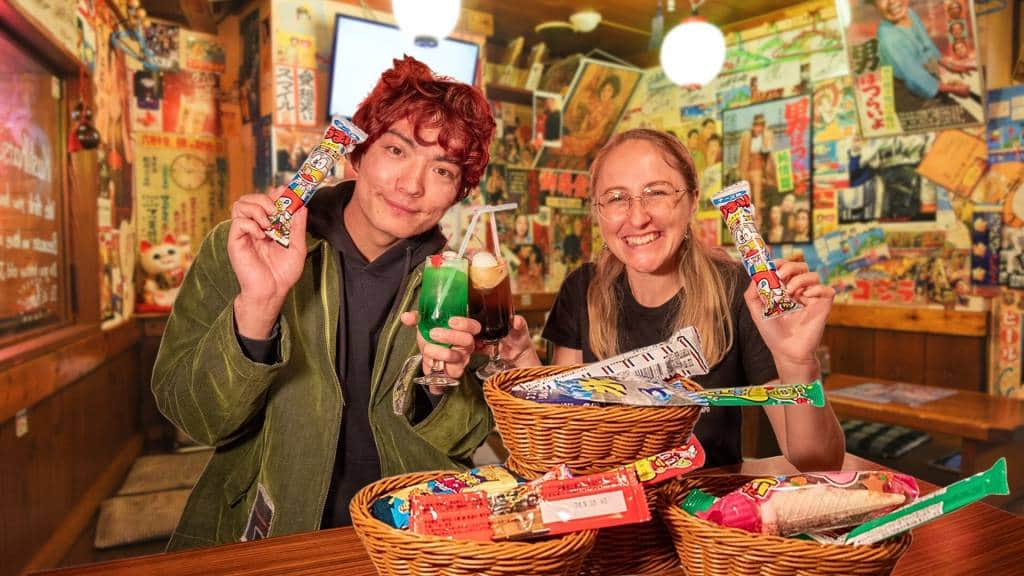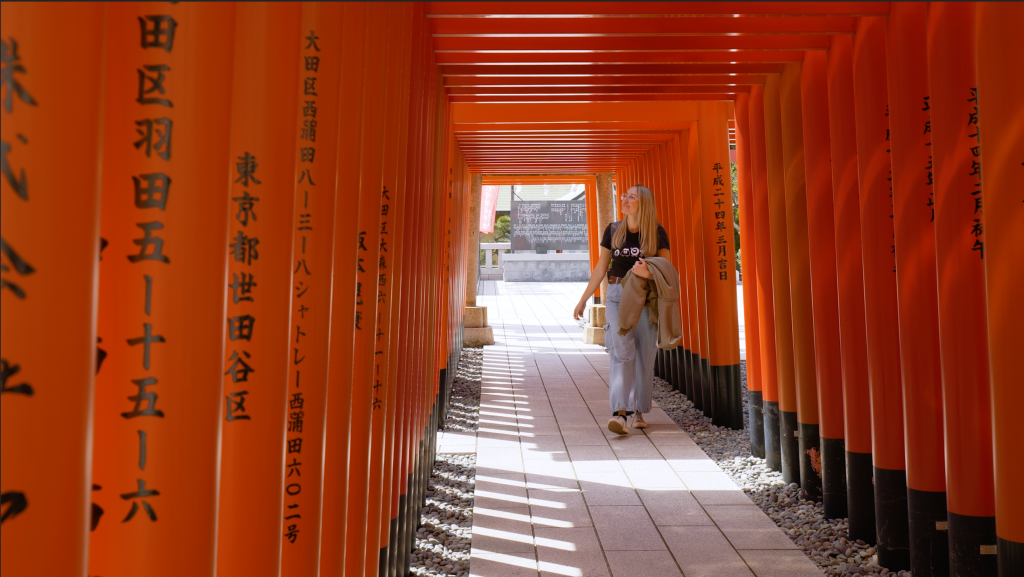Kabukichō is the biggest red-light district in Tokyo, where you can find everything from adult entertainment to prehistoric reptiles, neon samurai shows, acclaimed bars and restaurants, love hotels, and more. Whether you’re keen to try out the dodgier side of Tokyo’s nightlife or just want to explore the streets, there are plenty of things to do in Kabukichō. Any place that has Godzilla as an ambassador has to be worth checking out!
1. Experience the Samurai Restaurant

In the old days, visitors would flock to the legendary Robot Restaurant in Kabukichō. That is closed, but the new Samurai Restaurant, which opened in October 2023, is proving just as popular — and just as crazy.
¥8,900 gets you access to a mind-bending display of dance moves, LED lights, live singers, sword play — and just generally bizarre characters from Japanese pop history. It’s a two-hour show that you won’t forget in a hurry. A light meal and drinks are included. Book tickets to the Samurai Restaurant in Kabukicho.
2. Go for a drink (or many) in Golden Gai
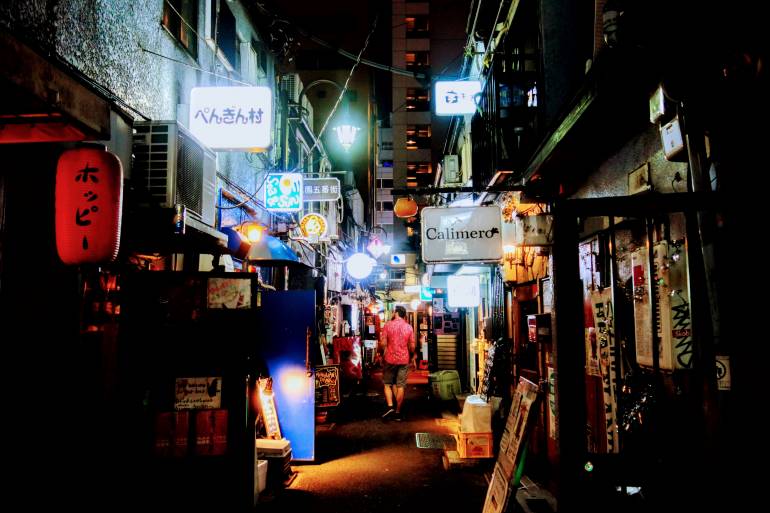
Golden Gai is one of the most popular drinking spots in Kabukichō, though it has a markedly different vibe from the red-light district. It’s a heaping cluster of tiny bars, spilling out of narrow alleys. You won’t usually see touts, and the only fees you have to worry about here are the cover charges (which range from 0 to ¥1,000), so you can rest easy.
Two of the best Golden Gai bars include Kenzo’s Bar (super friendly), and Hair of the Dogs, which is a rock bar that plays constant concert DVDs, by request.
The bars in Golden Gai each have their own style and atmosphere, making a pub crawl a fun way to spend an evening. See our full guide to where to drink in Golden Gai.
Charges are clearly marked on doors (along with some that have signs saying Japanese only — which is more about keeping spots for regulars than rudeness), and you can peek in to see if it tickles your fancy!
Also, Golden Gai is not the only yokochō (drinking alley) in Tokyo; take a look at our recommendations for other atmospheric Tokyo alleyways in which to knock back some beers.
3. Get running from Godzilla

The official local ambassador, the giant Godzilla is now a permanent feature and on occasion will light up and roar, which never ceases to be entertaining. He can be spotted from afar and makes a great meeting place (way cooler than Hachikō), as he sits right in the middle of Kabukichō.
He is actually part of Hotel Gracery, and you can book rooms with a view of his face, or take a tour up to the roof to see him close up. The Toho Cinema (same building as the hotel) is also a recommended place to see movies, either dubbed or subtitled, as they have a great selection — perfect for a rainy day.
4. Check out Kabukichō Tower

Kabukichō Tower is another new kid on the block. The multi-story entertainment complex opened in April 2023, and has a game center, escape room, food hall, and live music venue.
The game center is flashier than most arcades, with lots of neon lights and even a giant crane game. Plus, there is a bar in the center where you can buy drinks (even alcoholic ones), and canned food (canned mackerel in chocolate, anyone?).
The escape room — called “The Tokyo Matrix” — is inspired by the anime Sword Art Online, and is more like an obstable course or dungeon, than a traditional escape room. And be warned, it’s actually really difficult — gameover means you have to leave, or pay more to continue. Tickets to The Tokyo Matrix escape room cost ¥2,000–¥2,450, depending on the day of the week, and how far in advance you book.
If you enjoy escape rooms, you should also check out Tokyo Mystery Circus, which is very close to Kabukichō Tower.
5. Hit a homerun at a Japanese batting center

Kabukichō has not one but two batting centers — Shinjuku Batting Center and Oslo Batting Center — proving that innocent fun is among the neighborhood’s many (many) offerings.
Shinjuku Batting Center definitely looks its age — it’s been around since the 1970s. It’s also one of the cheapest spots in Kabukichō, costing just ¥300 for 26 pitches. You’ll see serious hitters here, taking advantage of the 80mph (130kph) fast balls, as well as young couples goofing off. Oslo Batting Center is a little more modern, and prices start at ¥1,300 for three games.
6. Soak your worries away at Thermae-Yu
If you’ve missed your last train and don’t want to fork out for a hotel, Thermae-Yu is a great option. This hot-spring facility is open 24 hours a day, seven days a week, and has several baths and saunas so you won’t get bored. There’s even a massage service and restaurant, although these aren’t open 24 hours.
Entry starts at ¥2,700 depending on the day, and there is a late night/early morning surcharge of ¥2,000 to ¥2,300.
7. Try your luck at a pachinko parlor

As close as Japan gets to legal gambling, pachinko is a popular pastime with more parlors than you can shake a stick at in this dodgy district. Now, if you hope to understand this game, good luck. The screaming racket that emanates from these glowing halls every time a door opens is genuinely quite horrifying — but you can give it a go.
Insert your money into the machine and wait for the happy crashing of tiny silver balls, then begin — you might win more, you might not. Who knows. It’s fun to try though, and obviously pretty addictive.
Each tiny ball costs between ¥1 to ¥4 yen, so you can keep it cheap if you just want to try, but be careful — it can quickly add up. Your aim is to make the balls land between the pegs, and the strength with which you turn the handle determines how strong they shoot out.
Due to people spending insane amounts of money over long hours, security are quick to chuck people out over privacy fears, so head in with confidence and sit down straight away to show you aren’t just gawking. Avoid very empty parlors, as they probably have a reputation for low payouts. And if you’re serious, check the stats on the top of each machine to work out which has the best chance of paying out.
Note: You have to be 18 or older to enter a pachinko parlor. Also, taking photos or videos will probably not be permitted.
8. Go shopping at Don Quijote

Don Quijote — better known as “Donki” — is Japan’s original all-night shopping emporium. Fitting, for a neighborhood where most of the working population necessarily keeps odd hours.
Donki stocks assorted sundries, like food, alcohol, toiletries, home goods, sex toys, and role-play costumes — wait, what? Yes, Donki sells all kinds of stuff in its narrow, crammed aisles. Excellent for souvenir hunting, or when you have time to kill before the trains start running again in the morning.
9. Spend the night in a love hotel

For a night you won’t forget, try visiting a love hotel. Whether you opt for the full night stay or a short “rest,” you can experience all kinds of weirdness and maybe get some shuteye (or not). Depending on your budget, you can enjoy your own private hot tub, costumes, in-room light shows, and much more. While some are definitely pretty grim, the more upmarket ones are respectable, for example Bali Hotel An Resort, or Hotel Moana.
Alternatively, you could visit the movie-famous Hotel Atlas (from the film Kabukichō Love Hotel), which offers discounts for girl groups.
See more tips about booking love hotels in Japan.
10. Take a breather at Hanazono Shrine

Shintō shrine Hanazono-jinja has been standing guard over Shinjuku since the beginning of the Edo period (1603–1868), and likely earlier. It’s an “inari” shrine, which means its good for business and trade — which is rather fitting for the neighborhood. There’s also a small sub-shrine, Geino Asama-jinja, that is popular with entertainers who come to pay their respects before big gigs.
The shrine hosts festivals throughout the year. Most noteworthy is the Tori-no-ichi (“Rooster Market”) in November, which is also all about prosperity. There is also has a regular Sunday flea market.
The shrine itself isn’t much to look at — the buildings, though traditional-looking, are all modern constructions. What’s most impressive is that this oasis of calm exists in the middle of Kabukichō. There are two entrances to Hanazono-jinja: via the big stone torii gate on Meiji-dōri, or via the lantern lit path from Golden Gai.
Bonus: Wagyu and Sake Pairing
Just a short walk from Kabukicho in Nishi Shinjuku, this restaurant offers an impressive 8+ course meal that pairs high-quality wagyu beef with a variety of Japanese craft sake. Guests can enjoy wagyu prepared in several styles, enhancing its natural taste, alongside sake served in unique ways, including original cocktails designed for the wagyu pairing. This experience also offers insights into the history and regional differences of wagyu and sake in Japan.
While we do our best to ensure it’s correct, information is subject to change. Post first published in March 2017. Last updated in November 2023.



